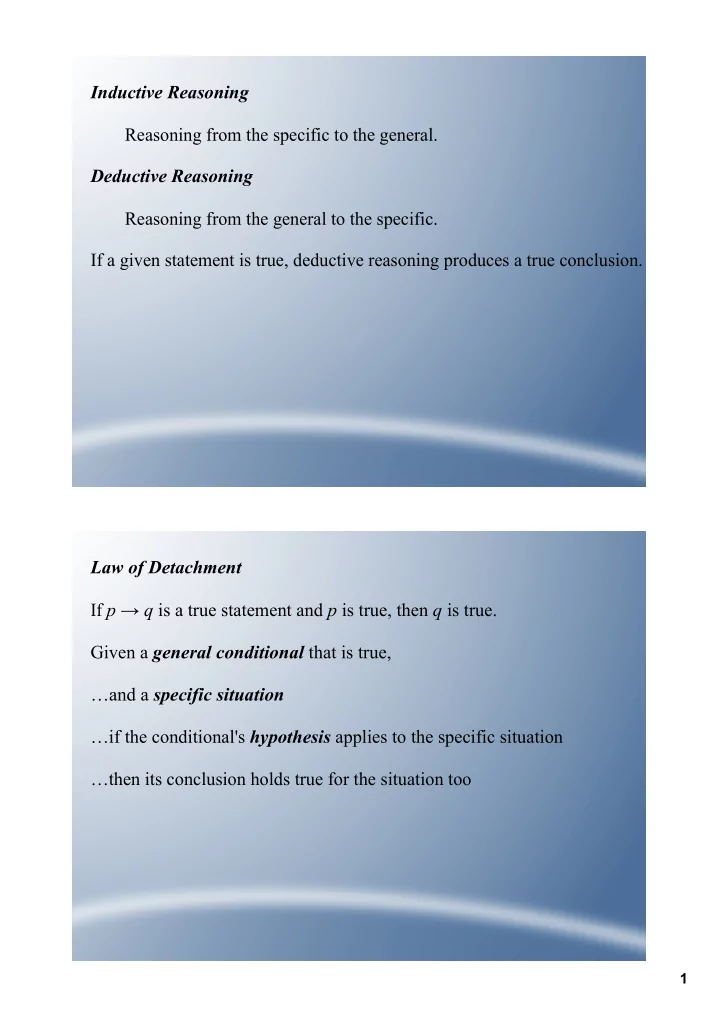

Inductive Reasoning Reasoning from the specific to the general. Deductive Reasoning Reasoning from the general to the specific. If a given statement is true, deductive reasoning produces a true conclusion. Law of Detachment If p → q is a true statement and p is true, then q is true. Given a general conditional that is true, …and a specific situation …if the conditional's hypothesis applies to the specific situation …then its conclusion holds true for the situation too 1
Example – Pg 83, Check Understanding #2 Given: If a baseball pitcher is a pitcher, then that player should not pitch a complete game two days in a row. Vladimir Nuňez is a pitcher. On Monday, he pitches a complete game. Does the specific situation relate directly to the conditional's hypothesis? Yes ∴ can use Law of Detachment Conclusion: Vladimir should not pitch a complete game on Tuesday Example – Pg 83, Check Understanding #3 Given: If a road is icy, then driving conditions are hazardous Driving conditions are hazardous Does the specific situation relate directly to the conditional's hypothesis? No – situation relates to the conclusion not the hypothesis. Can not use Law of Detachment 2
The Law of Detachment review Applies if you have 1 conditional and 1 statement: 1) true general conditional 2) specific situation/statement 3) specific situation directly relates to hypothesis of conditional 3
The Law of Syllogism If p → q and q → r are true statements, then p → r is true If you have a chain of conditionals… …the conclusion of one… …is the hypothesis of the next… Then you can say the final conclusion follows directly from the initial hypothesis... ...can skip all the middle stuff & jump straight to final conclusion! Kind of like the Transitive Law of Logic ( not formally called this...) 4
Example – Pg 83, Check Understanding #4 part a If a number ends in 0, then it is divisible by 10. If a number is divisible by 10, then it is divisible by 5. Clear & consistent chain? Both statements are true? Therefore we can conclude p → r . Conclusion: If a number ends in 0, then it is divisible by 5. Example – Pg 83, Check Understanding #4 part b If a number ends in 6, then it is divisible by 2. If a number ends in 4, then it is divisible by 2. Clear & consistent chain? Conclusion of one is not the hypothesis of the next. Not possible to apply the Law of Syllogism. 5
The Law of Syllogism review Applies if you have ≥ 2 conditionals: 1) form a connected chain 2) conclusion of each one matches hypothesis of next Law of Detachment Law of Syllogism The Law of Syllogism review • 1 conditional • ≥ 2 conditionals • 1 statement • connected chain... • statement ⇒ hypothesis • conclusion ⇒ hypothesis, conclusion ⇒ hypothesis, conclusion ⇒ hypothesis, ... 6
Example – Pg 86, #22 Statement Conditional All national parks If a park is a national park, are interesting. then it is interesting. Statement 2 : Mammoth Cave is a national park. Which law appears to apply here...Detachment or Syllogism? Does statement 2 directly related to the hypothesis of the conditional? Yes, can use Law of Detach…conclusion: Mammoth Cave is interesting. Example – Pg 86, #22 Statement 1 : All national parks are interesting. Conditional : If a park is a national park, it is interesting. Statement 2 : Mammoth Cave is a national park. Statement 2 directly related to the hypothesis Can use Law of Detach… Mammoth Cave is interesting. 7
What about this? If a number is divisible by 10, then it is divisible by 5. If a number ends in 0, then it is divisible by 10. What about this? If a number ends in 0, then it is divisible by 10. If a number is divisible by 10, then it is divisible by 5. Which law appears to apply here...Detachment or Syllogism? Clear & consistent chain? Both statements are true? Therefore we can conclude p → r . If a number ends in 0, then it is divisible by 5 if reorder the statements. 8
...and how about this? If a number ends in 0, then it is divisible by 10. If a number is divisible by 10, then it is divisible by 5. If a number is divisible by 5, then it is divisible by 2. Which law appears to apply here...Detachment or Syllogism? Clear & consistent chain? All statements are true? Chain is broken by a false conditional statement... 9
Recommend
More recommend